What The Points Guy website calls “the largest operational meltdown in Southwest’s history” is continuing, with the airline canceling 2,900 flights on Monday alone and delaying another 800. That represents about 85% of Southwest’s flights for the day.
While other major carriers are nearly back to a normal flight schedule, Southwest is suffering inexplicable delays and cancelations, enraging hundreds of thousands of people.
That’s not the worst of it. By 11 p.m. ET on Monday night, the carrier had already canceled more than 2,400 flights for Tuesday and over 2,300 for Wednesday. Flight rebooking for stranded passengers will not be available until Friday, according to CNN. And the airline announced new bookings won’t be available until January 3.
“As the storm continued to sweep across the country, it continued to impact many of our larger stations, and so the cancelations just compiled one after another to 100 to 150 to 1,000,” Southwest spokesman Jay McVay said at a news conference at Houston’s William P. Hobby Airport on Monday night.
“With those cancelations and as a result, we end up with flight crews and airplanes that are out of place and not in the cities that they need to be in to continue to run our operations.”
Some of the weather was unexpected, including fog in San Diego and worse conditions in Denver than originally expected, according to a CNBC report.
But, Mother Nature didn’t specifically try to snarl Southwest’s operations — all major U.S. airlines were up against the same conditions.
It was the recovery that Southwest seemingly botched. Staffing and technology problems combined to send the carrier on a downward spiral.
In Denver, The Denver Post noted that “an unusually high number of absences among ramp agents” hurt Southwest’s operations there as the storm first began to affect the city. Though conditions have since improved in Denver, the carrier’s operations there remained poor for most of Christmas week.
Not unexpectedly, Joe Biden’s Transportation Department is riding to the rescue—or, at least, preparing to conduct the obligatory witch hunt to assign blame.
USDOT is concerned by Southwest’s unacceptable rate of cancellations and delays & reports of lack of prompt customer service. The Department will examine whether cancellations were controllable and if Southwest is complying with its customer service plan.
— TransportationGov (@USDOT) December 27, 2022
The government probably won’t have to dig very deep to uncover the reasons for the biggest holiday clusterfark in recent memory.
#Southwest says it's not subject to Department of Transportation when cancelling. Here's how they did it in Denver. No vouchers, no flights for three days at least. No compensation. They knew they didn't have staff days ago. pic.twitter.com/xnRddHZg3e
— b (@thelamiam) December 27, 2022
Heads should roll at SWA—especially the CEO who knew about the issues that caused the meltdown but apparently didn’t fix them.
On Christmas night, ahead of Monday’s meltdown, Jordan told employees the airline has “a lot of issues in the operation right now.”
CNN was provided a transcript of the message to Southwest employees by an aviation source.
Jordan told employees, “Part of what we’re suffering is a lack of tools. We’ve talked an awful lot about modernizing the operation, and the need to do that.”
Some consumer aviation experts are warning that Southwest won’t be back to “normal” operations for several weeks. What’s described as “old-school technology”—acknowledged in Jordan’s statement—along with what were surely misjudgments and other errors, led to the spectacle of a huge airline being brought to a standstill by management’s shortsightedness.
Southwest Airlines used to be a no-frills airline that benefitted hugely from airline deregulation in the 1980s. It appears that the “no-frills” now applies to the technology and procedures used to help the airline survive a weather crisis.










Join the conversation as a VIP Member